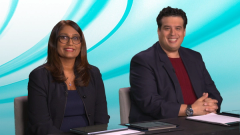
Transplant-Ineligible NDMM: Optimizing Selection and Duration of Therapy
Practical perspectives on the optimal selection of therapy for transplant-ineligible NDMM, followed by considerations for duration of therapy and dosing.
Episodes in this series

Transcript:
Sundar Jagannath, MD: Josh, how do you select doublet vs triplet [therapy] for older patients?
Joshua Richter, MD: We’re not using classical chemotherapy. In the age of novel therapies, I give the majority of my patients’ triplet, and I’d rather give them a dose-adjusted triplet as opposed to a full-dose doublet. In this context, you mentioned the first trial, where Rd [lenalidomide, dexamethasone] became the standard [in the United Kingdom], and where VMP [bortezomib, melphalan, prednisone]became the standard from some of the older trials, like VISTA. The ALCYONE [trial] gives daratumumab–VMP [bortezomib, melphalan, prednisone]. Europe is giving quadruplets to transplant-ineligible older patients. [If it’s] properly dose-adjusted, I’d rather give 15 mg of Revlimid and 20 or 12 mg of dexamethasone alone with daratumumab or bortezomib as opposed to 25 and 40 mg. That’s because of the multiple subclones of myeloma. You can try to pick off more with multiple mechanisms of action and get a deeper remission and ultimately better outcomes.
In terms of whom we pick this for, as you had mentioned, we have to consider frailty. There are patients who are frailer or fitter than others, and oftentimes we don’t do this as robustly as we ought to. One of my old professors used to say that if we walk into the room and the patient has the eye of the tiger, we give them a full regimen. If they don’t have the eye of the tiger, we don’t. But there are some wonderful people doing research into this, such as our colleague Larysa Sanchez, who is looking at some of the more formal ways of assessing this with some of the questionnaires, like the EORTC QLQ-C30 [European Organization for the Research and Treatment of Cancer Quality of Life Questionnaire], and some tests you can do in the clinic, like the 4-minute walk test.
Sundar Jagannath, MD: Instead of looking at the eye of the tiger, you might as well look at how fast [the patient is]. The gait speed is much more useful. Anyway, in this older patient, how do you tailor your therapy? You talked about the frontline transplant-eligible patients, and you talked about MRD [minimal residual disease] as your goal. In this older-patient population, what are your objectives for managing the patient? Is MRD still your goal? How do you want to manage that?
Shambavi Richard, MD: When it comes to older [individuals], there are a couple of things that are a little different from younger patient. No. 1, toxicity management becomes very important. The older [individuals] feel the toxic effects and cannot weather toxicities as well. In addition to the goal of getting to that best response—ideally, MRD-negative regardless of age, frailty, or anything else—we have to keep an eye on the toxicity. In terms of the goal [with the disease, [I would] absolutely still go for that same goal. It’s even more important when you think of older [individuals], for 2 reasons. No. 1, they don’t do as well when they have disease, and you have to intensify the treatments to try to get rid of the disease. They don’t do well when they relapse. There’s a high attrition rate. Not everybody is going to get onto that second-line novel therapy that works so well for the young patient. I still go for the deepest response possible, ideally MRD-negative. That remains my goal for older [individuals].
Sundar Jagannath, MD: With transplant, you talked about continuous therapy with maintenance and that you wanted to maintain them until they relapse. That was your take on the DETERMINATION trial. You said it gave a wonderful PFS [progression-free survival]; the transplant arm especially was very good. In older patients, do you have the same principle of maintaining forever? Or do you maintain to a point, a fixed length like the French did for instance, with 2 years of maintenance? What’s your philosophy?
Shambavi Richard, MD: Looking at the MAIA trial, their goal was to give DRd [daratumumab, lenalidomide, dexamethasone] all the way to progression. That was a hefty dose of Revlimid [lenalidomide] for somebody who’s 85 [years old]. I don’t know if many 85-year-olds would be able to tolerate 25 mg of Revlimid. Overall, if we want to mimic the results of DRd [daratumumab, lenalidomide, dexamethasone] in our clinic, then treating to progression is probably 1 of the things we have to keep an eye on. But we may have to dose adjust as we go along. I’m not sure. It depends. It has to be tailored to the individual patient. Not every older patient is the same. They may be quite different in terms of their ability to weather treatment, even if all things seem equal when they first walk in the door. How well they tolerate treatment will be displayed as we go along with treatment. My rule of thumb is to continue to progression. Having said that, if somebody is not tolerating well and has a great response and needs a little break from the treatment, nothing is off the table.
Transcript edited for clarity.
Newsletter
Stay up to date on recent advances in the multidisciplinary approach to cancer.










